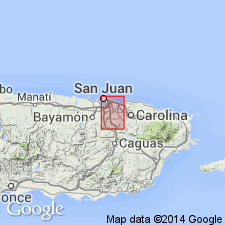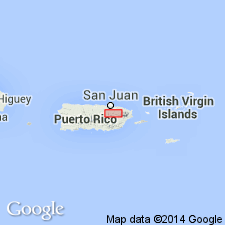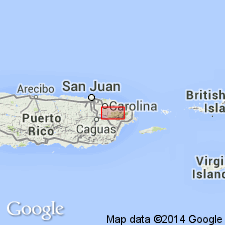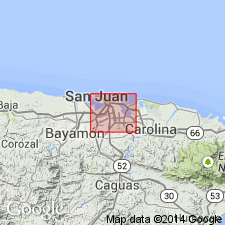
- Usage in publication:
-
- Monacillo formation*
- Modifications:
-
- Named
- Dominant lithology:
-
- Volcaniclastics
- AAPG geologic province:
-
- Caribbean region
Summary:
The Monacillo formation, here named, consists of a heterogeneous mixture of beds of clastic tuffaceous and volcanic rocks, maroon in color, ranging in texture from siltstone to conglomerate, and variable thickness, 900 ft or more. Conformably overlies the Frailes formation; conformably underlies the Trujillo Alto limestone. Age is Late Cretaceous based on fossils in adjoining formations.
Source: GNU records (USGS DDS-6; Reston GNULEX).

- Usage in publication:
-
- Monacillo Formation*
- Modifications:
-
- Revised
- AAPG geologic province:
-
- Caribbean region
Summary:
The Monacillo Formation is here revised to include the Trujillo Alto Limestone Member, mapped by Kaye (1959) as the Trujillo Alto Limestone, but shown by recent mapping to be a more restricted unit than Kaye had shown and overlain in most places by bedded mudstone, sandstone, and siltstone of the Monacillo. Monacillo unconformably overlies the Leprocomio Siltstone Member of the Guaynabo; unconformably underlies the Guaracanal Andesite. Is stratigraphically equivalent to the La Muda Formation. Age is Late Cretaceous (probably late Maastrichtian) based on fossils in the Trujillo Alto Member.
Source: GNU records (USGS DDS-6; Reston GNULEX).

- Usage in publication:
-
- Monacillo Formation*
- Modifications:
-
- Age modified
- AAPG geologic province:
-
- Caribbean region
Summary:
Stratigraphic relationships suggest a disconformity between the Leprocomio Mudstone Member of the Frailes and the Trujillo Alto Limestone Member of the Monacillo of about 450 m of Cretaceous rocks. Age of the Monacillo is set by late Campanian Leprocomio and Late Cretaceous or possibly Tertiary Trujillo Alto. Age is Campanian or Maastrichtian, possibly early Tertiary in upper part.
Source: GNU records (USGS DDS-6; Reston GNULEX).

- Usage in publication:
-
- Monacillo Formation*
- Modifications:
-
- Age modified
- AAPG geologic province:
-
- Caribbean region
Summary:
Age of Monacillo Formation and its Trujillo Alto Limestone Member is Late Cretaceous.
Source: GNU records (USGS DDS-6; Reston GNULEX).

- Usage in publication:
-
- Monacillo Formation*
- Modifications:
-
- Overview
- AAPG geologic province:
-
- Caribbean region
Summary:
The Monacillo Formation occurs in eastern Puerto Rico and consists of conglomerate and mudstone interbedded with siltstone and sandstone, and locally limestone. Maximum estimated thickness is 400 meters. The Monacillo is of Late Cretaceous age.
Source: GNU records (USGS DDS-6; Reston GNULEX).
For more information, please contact Nancy Stamm, Geologic Names Committee Secretary.
Asterisk (*) indicates published by U.S. Geological Survey authors.
"No current usage" (†) implies that a name has been abandoned or has fallen into disuse. Former usage and, if known, replacement name given in parentheses ( ).
Slash (/) indicates name conflicts with nomenclatural guidelines (CSN, 1933; ACSN, 1961, 1970; NACSN, 1983, 2005, 2021). May be explained within brackets ([ ]).

